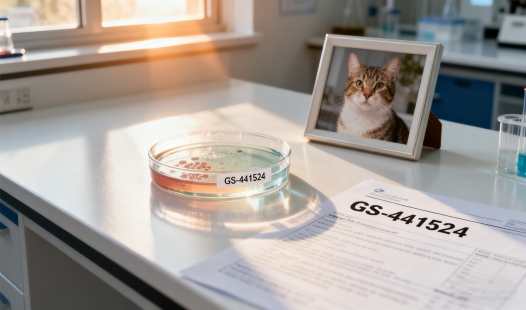When it comes to treating FIP, BLOOM TECH knows how important high-quality GS-441524 is. From the moment of FIP diagnosis, our team understands the urgency and precision required to ensure the best possible outcome for your cat. Strict quality control techniques are used throughout the manufacturing of our pharmaceutical-grade GS-441524, guaranteeing the utmost purity and effectiveness for the treatment of your feline friend. Our dependable supply chain and unwavering dedication to quality provide vets and cat owners with the necessary resources to successfully fight FIP. Don't let FIP hold your cat back – choose BLOOM TECH for a trusted GS-441524 supplier and take the first step towards your cat's recovery. Contact us at Sales@bloomtechz.com to learn more about our GS-441524 products and how we can support your cat's journey to health.
What to Do If Your Cat Is Diagnosed with FIP?
First Steps: Creating an Action Plan
It may be a devastating and upsetting experience to learn that your favorite cat has Feline Infectious Peritonitis (FIP). Cat owners confronted with this deadly condition once again have reason to be hopeful, thanks to recent developments in veterinary treatment. In order to help you make educated choices about your cat's care and treatment after an FIP diagnosis, this detailed guide will lead you through the necessary procedures.
 |
 |
 |
First Steps: Creating an Action Plan
Upon receiving an FIP diagnosis, it's crucial to remain calm and focused. Your cat needs your support now more than ever. Here are the initial steps to take:
Understand the Diagnosis
When your cat is diagnosed with FIP, the first and most important step is to fully understand what the diagnosis means. Feline Infectious Peritonitis (FIP) results from a mutation of the feline coronavirus (FCoV), which is common in multi-cat environments. This mutation allows the virus to attack the immune system, leading to inflammation in various organs. FIP appears in two main forms: wet (effusive), which causes fluid buildup in the abdomen or chest, and dry (non-effusive), which affects organs like the eyes, brain, or liver. Knowing which form your cat has is essential, as it determines the treatment strategy, prognosis, and potential response to therapies such as GS-441524 or other antiviral options.
Consult with a Feline Specialist
While your regular veterinarian may confirm the initial diagnosis, consulting with a feline infectious disease specialist or an experienced FIP veterinarian is highly recommended. Specialists stay updated on the latest FIP treatment protocols, including dosage guidelines, monitoring techniques, and supportive care strategies. They can also provide tailored recommendations based on your cat's age, weight, and disease stage. A second opinion may reveal additional diagnostic tests—such as PCR or antibody titers—that help confirm the diagnosis with greater accuracy. This collaboration ensures that your cat receives the most effective and compassionate care possible during the early stages of treatment.
Gather Information
Becoming well-informed is one of the best ways to support your cat through this difficult time. Take the initiative to research FIP symptoms, current treatment options, and success stories from reliable veterinary resources. Many veterinarians and research organizations publish detailed case studies that can help you understand what to expect throughout the recovery journey. Online FIP support groups can also provide emotional support and practical advice from other pet owners who have gone through similar experiences. However, always verify information with a trusted veterinary professional before acting on it. The more you know, the more confident and capable you'll feel in making the best decisions for your cat's health.
|
|
|
|
Treatment Options: Making Informed Decisions
Recent breakthroughs in FIP treatment have significantly improved the prognosis for affected cats. Here are some treatment options to discuss with your veterinarian:
Antiviral Therapy
One of the most promising treatments for FIP involves the use of antiviral medications. GS-441524, a nucleoside analog, has shown remarkable success in clinical trials and real-world applications. This compound works by inhibiting viral replication, effectively halting the progression of FIP.
Supportive Care
In addition to antiviral therapy, supportive care is crucial for managing FIP symptoms and improving your cat's quality of life. This may include:
- Fluid therapy to address dehydration
- Nutritional support through high-quality, easily digestible diets
- Anti-inflammatory medications to reduce fever and discomfort
- Regular monitoring of blood work and other diagnostic tests
Experimental Treatments
As research into FIP continues, new experimental treatments may become available. Discuss with your veterinarian the possibility of enrolling in clinical trials or accessing cutting-edge therapies that might benefit your cat.
Building Your Support Network
Caring for a cat with FIP can be emotionally and physically demanding. Building a strong support network is essential for both you and your feline companion.
Connect with FIP Support Groups
Joining online or local FIP support groups can provide invaluable emotional support and practical advice from others who have gone through similar experiences. These communities often share the latest information on treatments and can offer guidance on navigating the challenges of FIP care.
Communicate with Your Veterinary Team
Maintain open and regular communication with your veterinary team. They can provide ongoing support, answer questions, and adjust your cat's treatment plan as needed. Don't hesitate to reach out if you have concerns or notice changes in your cat's condition.
Involve Family and Friends
Share your cat's diagnosis with close family and friends. Their support can be invaluable, whether it's helping with medication administration, providing emotional support, or assisting with daily care tasks.
Conclusion
An FIP diagnosis is undoubtedly challenging, but it's no longer the dire prognosis it once was. With advancements in treatment options, particularly the promising results of GS-441524, many cats are now surviving and thriving after FIP treatment. By taking proactive steps, staying informed, and building a strong support network, you can give your cat the best possible chance at overcoming this disease. Remember, each cat's journey with FIP is unique, and with dedication and proper care, there is hope for a positive outcome.
FAQ
1. Q: How long does FIP treatment typically last?
A: The duration of FIP treatment can vary depending on the individual case and the specific protocol used. However, most treatment plans with GS-441524 or similar antivirals typically last 84 days (12 weeks). Some cases may require longer treatment periods, especially if neurological symptoms are present.
2. Q: Can cats fully recover from FIP?
A: Yes, with the advent of new antiviral treatments, many cats can fully recover from FIP. Success rates vary, but studies have shown that a significant percentage of cats treated with GS-441524 or similar compounds achieve remission and go on to live normal, healthy lives.
3. Q: Are there any side effects associated with FIP treatments?
A: While GS-441524 and other antiviral treatments have shown to be generally well-tolerated, some cats may experience side effects. These can include injection site reactions, gastrointestinal upset, or temporary changes in behavior. It's crucial to discuss potential side effects with your veterinarian and report any concerns during treatment.
Empower Your Cat's Fight Against FIP with BLOOM TECH's Premium GS-441524
References
1. Pedersen, N.C., et al. (2019). Efficacy and safety of the nucleoside analog GS-441524 for treatment of cats with naturally occurring feline infectious peritonitis. Journal of Feline Medicine and Surgery, 21(4), 271-281.
2. Addie, D.D. (2020). Feline Infectious Peritonitis: New Insights into an Old Enemy. Veterinary Sciences, 7(4), 179.
3. Murphy, B.G., et al. (2018). The nucleoside analog GS-441524 strongly inhibits feline infectious peritonitis (FIP) virus in tissue culture and experimental cat infection studies. Veterinary Microbiology, 219, 226-233.
4. Tasker, S. (2018). Diagnosis of feline infectious peritonitis: Update on evidence supporting available tests. Journal of Feline Medicine and Surgery, 20(3), 228-243.

Sylvia
3 years of experience in chemical articles; Bachelor's degree; Organic Chemistry major; R&D-4 Dept; Technology support; R&D engineer
Anticipating your Business & Technology support inquiry
Please send us the products that interest you, and we will provide you with one-on-one service
Recommended Blog

What Are the Side Effects of GS-441524? And How to Manage Them Effectively?

What are the differences in treatment for wet and dry FIP?
_副本_1761184166100.webp)
Understanding FIPV in Multi-Cat Households: Risks and Prevention

A Step-by-Step Guide to Giving GS-441524 Injections to Your Cat at Home





_副本_1758779278502.webp)
_副本_1758519070270.webp)
_副本_1758852146010.webp)



